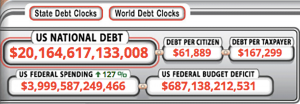By Raven Clabough
On September 8, the same day that President Trump signed a bill into law that suspended the debt ceiling and enabled unlimited federal borrowing, the national debt reached and exceeded $20 trillion for the first time in U.S. history.
It’s not as though it was much better before Friday, however, as the debt ceiling has been sitting comfortably at approximately $19.8 trillion since March. However, as a result of President Trump’s deal with the Democrats that raised the debt ceiling and also provided federal aid to the victims of the recent hurricanes, the Treasury Department was able to begin immediately borrowing money following months of being forced to use “extraordinary measures” to avoid exceeding the debt ceiling.
Under President Trump’s deal with the Democrats, the federal government will not have any spending cap until December 8, when a new debt ceiling will be in put in effect.
 President Trump taunted Republicans following his deal with the Democrats with a tweet in which he ultimately blamed the GOP for forcing his hand and compelling him to reach across the aisle. “Republicans, sorry, but I’ve been hearing about Repeal & Replace for 7 years, didn’t happen! Even worse, the Senate Filibuster Rule will never allow the Republicans to pass even great legislation. 8 Dems control – will rarely get 60 (vs. 51) votes. It is a Repub Death Wish…”
President Trump taunted Republicans following his deal with the Democrats with a tweet in which he ultimately blamed the GOP for forcing his hand and compelling him to reach across the aisle. “Republicans, sorry, but I’ve been hearing about Repeal & Replace for 7 years, didn’t happen! Even worse, the Senate Filibuster Rule will never allow the Republicans to pass even great legislation. 8 Dems control – will rarely get 60 (vs. 51) votes. It is a Repub Death Wish…”
Sadly, congressional Republicans, allegedly the fiscally conservative ones, were complicit in President Trump’s agenda to achieve a legislative victory at the expense of his campaign promises and the American people. GOP leadership could have refused to bring up his deal for a vote, but instead, the legislation passed quickly in the House and Senate with overwhelming bipartisan support.
And though President Trump campaigned on opposition to the growing national debt under President Obama, he has now vocalized support for getting rid of the debt ceiling altogether. “For many years people have been talking about getting rid of debt ceiling altogether and there are a lot of good reasons to do that,” Trump said. “So certainly, that is something that could be discussed.”
But as noted by former Texas Congressman Ron Paul, this would be a disaster for the economy. “This would put the growth of government spending and debt on autopilot and make a mockery of his promise to drain the swamp,” Paul wrote in an editorial. “It would also hasten America’s economic day of reckoning.”
In the absence of a debt ceiling, the national debt typically increases by leaps and bounds, notes the Washington Examiner. When President Obama lifted the debt ceiling in 2015, for example, the national debt jumped $339 billion in just one day. Under Trump, it exploded by more than $317 billion overnight.
It goes without saying that the financial health of the United States is projected to be rather bleak, as the Office of Management and Budget also projects that the government will run a $702 billion deficit for 2017.
With the debt now over $20 trillion, the president of the globalist Peter G. Peterson Foundation, Michael A. Peterson, told The Hill that this new record will force the United States to pay $6 trillion in interest over the next decade. “That’s more than we will invest in our kids. So, in effect, we have decided to spend more on our past than on our future,” he added.







